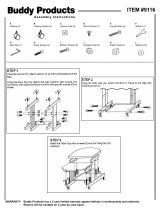
12
Directory
Directory
The 9116 telephone directory can store the names and telephone numbers of up to
twenty of your business associates, clients, contacts, friends and relatives for easy dialing.
Each directory record is numbered and identiÞed by the number appearing in the bot-
tom, right hand corner of the screen display. Names and numbers can be manually
entered into the Directory using the keypad or transferred into the Directory from the
screen display.
If all twenty directory records are used, the display will indicate
DIRECTORY FULL.
(See Deleting items from the Directory on page 14).
Saving numbers and names to the Directory
To save or edit a number and name: To save from the display:
1. Press J. The screen displays
directory record 1. Use the W or
V if this directory record is already
used or you wish to store this entry
under another directory record
number.
1. Ensure that a number is on the dis-
play (for example from the Callers
List).
2. Press K. The screen prompts you
to enter the phone number you wish
to save.
2. Press K. The screen shows
ENTER NUMBER.
3. Enter the number using the dial pad.
You can enter a maximum of 16 dig-
its. If you need to add a pause (for
example between a telephone num-
ber and an access code) press
C and the Pause icon will
appear. To program a number that
uses Flash, press the B key
where required and the Flash icon
will appear.
3. Press K again. The screen indi-
cates
ENTER NAME. If there is already
a name associated with the number
or you do not wish to have a name
with this directory entry, go to the
next step. Use the dialpad to enter
the name if required. See Entering
Names on page 13.
4. Press K. The screen prompts you
to enter the name you wish to save.
Use the dialpad to enter a name. See
Entering Names on page 13.
4. Press K again. Display shows
SAVED TO?
5. Press K. The display shows
SAVED:DIRECTORY.
5. Press K.
6. Press N to exit the Directory.
6. Press J. The screen indicates
SAVED: DIRECTORY and the entry is
saved in the next available directory
record.
7. Press N to exit the Directory.
9116 E UG.fm Page 12 Thursday, April 17, 2003 4:16 PM




















